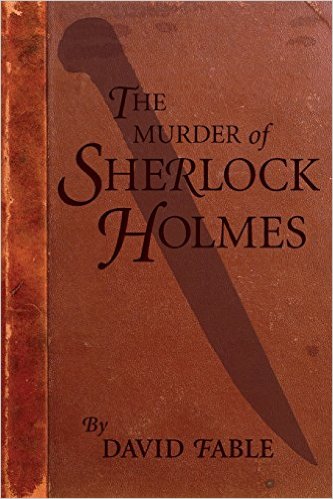Book Review: The Murder of Sherlock Holmes by David Fable
The Murder of Sherlock Holmes
by David Fable
 Sherlock Holmes has died and John Watson makes the heartbreaking decision to investigate what he believes is murder. The novel’s premises already indicated a strong diversion from the Canon, and yet it begins in typical fashion, with John Watson as the narrator. However, this time he is not alone in that venture. Scotland Yard, particularly Inspector Lestrade, and, more importantly, the young Christopher Hudson support him in what he believes to be his final case. Christopher is Mrs Hudson’s son whom Holmes had trained in his profession, even though he was sent to medical school by his mother. He throws himself into the case to find out who killed his idol.
Sherlock Holmes has died and John Watson makes the heartbreaking decision to investigate what he believes is murder. The novel’s premises already indicated a strong diversion from the Canon, and yet it begins in typical fashion, with John Watson as the narrator. However, this time he is not alone in that venture. Scotland Yard, particularly Inspector Lestrade, and, more importantly, the young Christopher Hudson support him in what he believes to be his final case. Christopher is Mrs Hudson’s son whom Holmes had trained in his profession, even though he was sent to medical school by his mother. He throws himself into the case to find out who killed his idol.
Set in 1912, David Fable creates an alternative universe for the characters of Arthur Conan Doyle’s stories. Fable’s book is split into two narrative strands – John Watson’s usual first person account is interwoven with Christopher Hudson’s narrative of the events. Very soon, it becomes clear that The Murder of Sherlock Holmes is not trying to imitate the canonical voice of Watson. The doctor seems a remnant of the Victorian age and young Hudson is depicted as a modern man who enjoys life to the fullest, preferring leather jackets to suits and driving a Harley Davidson through London. The story reads rather like a film and has little else but the setting and some of the characters in common with the Canon stories. Fable’s interpretation of the characters changes not only their behaviour (both Watson and Hudson often react to women with open animosity, foul language and sometimes unnecessary violence, something which is unthinkable in the Canon), but also strives to subvert Doyle’s narrative. Nothing is as it seems and John Watson is confronted with the realization that Holmes has kept some very private things from him, while James Moriarty becomes an unlikely ally in the case of Sherlock Holmes’s murder.
The book is fast paced and seems adamant at driving not only the plot, but also history forward. Brimming with side notes and references to turn of the century inventions, the reader occasionally feels like the book is trying to be both, novel and encyclopaedia of the advancements of the early 20th century at once. The most important canonical characters are present: James Moriarty, Mrs Hudson, the Scotland Yarders and the Baker Street Irregulars, who are all grown up now and a force to be reckoned with. Large parts of the narrative are concerned with the different ways in which Watson and Hudson deal with the death of Sherlock Holmes, while John Watson slowly gains an understanding of just how much the cards have been shuffled and redistributed.
While the novel itself is an enjoyable read, it doesn’t read like a typical Holmes pastiche – it is rather the opposite – a deconstruction of the Canon by giving the main characters greater weaknesses than Doyle ever did. The various failures, eccentricities and unlikable traits of the characters are visible throughout the book, just as London gains a rather claustrophobic quality, which creates an atmosphere that reminded me rather of Gotham City than Edwardian London.
The estrangement from the Canon also comes from the extensive use of US-American terminology and slang. Some rather unlikely elements, like Christopher Hudson driving around London in a Daimler (the company made the cars of the Royal families of Europe and provided busses, but for a normal middle class family to own one is incredibly unlikely, particularly since Christopher also owns a Harley Davidson) or the hundred and ten thousand pounds, which Holmes apparently had no issue obtaining from a bank (worth approximately 12 million Pound Sterling in 1912 and absolutely impossible to be simply picked up from a bank by an individual, even such an important individual as Sherlock Holmes) will be distracting to those who are familiar with the Canon and Edwardian England. The solution to the mystery is possibly the most drastic diversion from the Canon and seems a little too constructed and stereotypical to feel satisfactory.
The book is certainly entertaining, fast paced and complex, but I dare say that it is quite experimental and very different from what you would expect from a Sherlock Holmes pastiche.
(A review copy was kindly provided by the author)
You can purchase the novel at abebooks, amazon US, amazon UK, or any quality book store of your choice.

Maria teaches English Literature at Leipzig University, Germany, published a German introduction to Sherlock Holmes and is a fan of all things Holmes – but especially of the Canon stories and Sherlock BBC. Contact her at @stuffasdreams